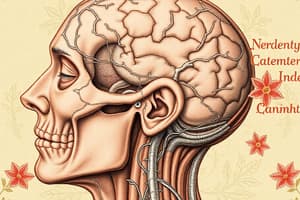Podcast
Questions and Answers
What is the basic functional unit of the nervous system?
What is the basic functional unit of the nervous system?
Neuron
Which areas of the brain are part of the cerebrum?
Which areas of the brain are part of the cerebrum?
- Basal ganglia (correct)
- Cerebellum
- Thalamus (correct)
- Brain stem
The hypothalamus is responsible for regulating the sleep-wake cycle.
The hypothalamus is responsible for regulating the sleep-wake cycle.
True (A)
The ________ is often referred to as the drunk center because injuries present with symptoms like stumbling and unsteady gait.
The ________ is often referred to as the drunk center because injuries present with symptoms like stumbling and unsteady gait.
Match the following structures with their descriptions:
Match the following structures with their descriptions:
What are neurotransmitters and what is their role in the nervous system?
What are neurotransmitters and what is their role in the nervous system?
Parkinson's disease occurs when nerve cells in the brain that make ________ are slowly destroyed.
Parkinson's disease occurs when nerve cells in the brain that make ________ are slowly destroyed.
What activities are controlled by the brain stem?
What activities are controlled by the brain stem?
Which lobe of the brain is responsible for sensory perception and size/shape discrimination?
Which lobe of the brain is responsible for sensory perception and size/shape discrimination?
Flashcards
Nervous System Function
Nervous System Function
Manages motor, sensory, autonomic, cognitive, and behavioral activities and maintains homeostasis.
Central Nervous System (CNS)
Central Nervous System (CNS)
Brain and spinal cord make up this division.
Peripheral Nervous System (PNS)
Peripheral Nervous System (PNS)
Cranial and spinal nerves, with autonomic and somatic systems.
Neurotransmitters
Neurotransmitters
Signup and view all the flashcards
Cerebrum
Cerebrum
Signup and view all the flashcards
Frontal Lobe
Frontal Lobe
Signup and view all the flashcards
Parietal Lobe
Parietal Lobe
Signup and view all the flashcards
Temporal Lobe
Temporal Lobe
Signup and view all the flashcards
Occipital Lobe
Occipital Lobe
Signup and view all the flashcards
Study Notes
Function of the Nervous System
- Manages all motor, sensory, autonomic, cognitive, and behavioral activities.
- Essential for communication between systems and maintaining homeostasis.
Structures of the Neurologic System
- Central Nervous System consists of the brain and spinal cord.
- Peripheral Nervous System includes cranial and spinal nerves, with autonomic and somatic systems.
- Neurons serve as the basic functional unit, with disease processes linked to neuronal damage.
Neurotransmitters
- Deficits in neurotransmitters can lead to various disorders.
- Facilitate communication between neurons and target tissues, controlling processes through potentiation, termination, or modulation.
- Parkinson's disease is caused by the loss of dopamine-producing nerve cells, affecting muscle function and coordination.
Major Areas of the Brain
- Comprises three key areas: Cerebrum, Brain Stem, and Cerebellum.
Cerebrum
- The largest brain area, divided into two hemispheres, includes the thalamus, hypothalamus, and basal ganglia.
- Four lobes:
- Frontal Lobe: Concentration, memory, motor function, and Broca’s area (speech production). Damage can alter personality and judgment.
- Parietal Lobe: Processes sensory information, proprioception, and spatial orientation.
- Temporal Lobe: Handles auditory processing and memory of sounds; damage affects language comprehension.
- Occipital Lobe: Responsible for visual interpretation and recall; damage can lead to vision loss or distortions.
Hypothalamus
- Connects to the pituitary gland; regulates autonomic nervous system activities.
- Oversees hormone secretion related to fluid balance, temperature regulation, appetite, sleep-wake cycles, and emotional responses.
Brain Stem
- Critical for life-sustaining functions; contains three main parts:
- Midbrain: Processes sensory and motor pathways and coordinates reflexes for auditory and visual stimuli.
- Pons: Supports sensory and motor pathways and plays a role in respiration regulation.
- Medulla Oblongata: Manages reflex centers for respiration, blood pressure, heart rate, and protective reflexes like coughing and swallowing.
Cerebellum
- Coordinates smooth movement and balance; crucial for proprioception and spatial awareness.
- Injury may present behaviors resembling intoxication, including unsteady gait and disorganized speech.
Meninges and Related Structures
- Dura Mater: Outermost layer, tough and inelastic.
- Arachnoid Mater: Middle layer, thin and delicate, loosely adheres to the brain and spinal cord, avascular.
- Pia Mater: Innermost layer, tightly covers brain and spinal tissue, highly vascularized.
Studying That Suits You
Use AI to generate personalized quizzes and flashcards to suit your learning preferences.




